
The London Underground is a rapid transit system serving Greater London and some parts of the adjacent home counties of Buckinghamshire, Essex and Hertfordshire in England.

The Waterloo & City line, colloquially known as The Drain, is a shuttle line of the London Underground that runs between Waterloo and Bank with no intermediate stops. Its primary traffic consists of commuters from south-west London, Surrey and Hampshire arriving at Waterloo main line station and travelling forward to the City of London financial district. For this reason, the line has historically not operated on Sundays or public holidays, except in very limited circumstances. Following the COVID-19 pandemic, the line is currently only open on weekdays. It is one of only two lines on the Underground network to run completely underground, the other being the Victoria line.
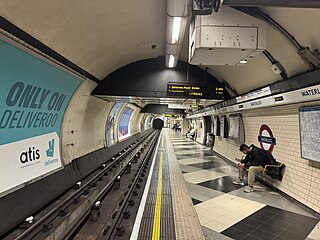
Waterloo is a London Underground station located beneath Waterloo National Rail station. As of 2023, it is the 2nd busiest station on the London Underground, with 70.33 million users. It is served by four lines: Bakerloo, Jubilee, Northern and Waterloo & City.
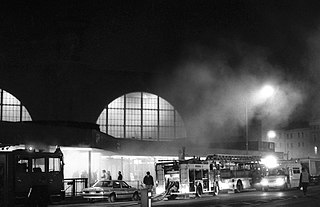
The King's Cross fire occurred in 1987 at King's Cross St Pancras tube station in London, England, causing 31 fatalities. It began under a wooden escalator before spreading into the ticket hall in a flashover.
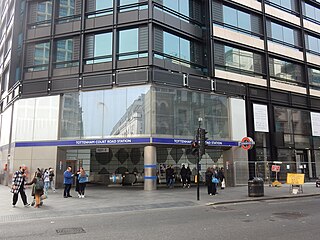
Tottenham Court Road is an interchange station in the West End of London for London Underground and Elizabeth line services.

Notting Hill Gate is a London Underground station near Notting Hill, London, located on the street called Notting Hill Gate. On the Central line, it is between Holland Park to the west and Queensway to the east. On the District line and Circle line, it is between High Street Kensington and Bayswater stations. It is on the boundary of Travelcard Zone 1 and Zone 2.

Aldwych is a closed station on the London Underground, located in the City of Westminster in Central London. It was opened in 1907 with the name Strand, after the street on which it is located. It was the terminus of the short Piccadilly line branch from Holborn that was a relic of the merger of two railway schemes. The station building is close to the Strand's junction with Surrey Street, near Aldwych. During its lifetime, the branch was the subject of a number of unrealised extension proposals that would have seen the tunnels through the station extended southwards, usually to Waterloo.

Finsbury Park is an intermodal interchange station in North London for London Underground, National Rail and London Buses services. The station is the third busiest Underground station outside Zone 1, with over 33 million passengers using the station in 2019.

Leicester Square is a London Underground station in the West End of London, within walking distance of Theatreland and Chinatown. It is located on Charing Cross Road, a short distance to the east of Leicester Square itself.
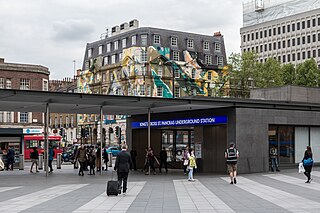
King's Cross St Pancras is a London Underground station on Euston Road in the Borough of Camden, Central London. It serves King's Cross and St Pancras main line stations in fare zone 1, and is an interchange between six Underground lines. The station was one of the first to open on the network. As of 2023, it is the most used station on the network for passenger entrances and exits combined.

Baker Street is a London Underground station at the junction of Baker Street and the Marylebone Road in the City of Westminster. It is one of the original stations of the Metropolitan Railway (MR), the UK's first underground railway, opened on 10 January 1863.
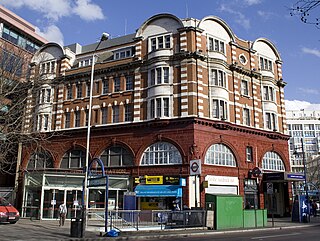
Elephant & Castle is a London Underground station in the London Borough of Southwark in south London. It is on the Bank branch of the Northern line between Borough and Kennington stations. It is also the southern terminus of the Bakerloo line and the next station towards north is Lambeth North. The station is in both Travelcard Zones 1 and 2. The Northern line station was opened in 1890 by the City and South London Railway (C&SLR) while the Bakerloo line station was opened sixteen years later by the Baker Street and Waterloo Railway (BS&WR). There is an out-of-station interchange with the nearby Elephant & Castle National Rail station.

Maida Vale is a London Underground station in Maida Vale in inner north-west London. The station is on the Bakerloo line, between Kilburn Park and Warwick Avenue stations, and is in Travelcard Zone 2.

Angel is a London Underground station in the Angel area of the London Borough of Islington. It is on the Bank branch of the Northern line, between King's Cross St. Pancras and Old Street stations, in Travelcard Zone 1. The station was originally built by the City & South London Railway (C&SLR) and opened on 17 November 1901. The station served as a terminus until the line was extended to Euston on 12 May 1907.

Barbican is a London Underground station situated near the Barbican Estate, on the edge of the ward of Farringdon Within, in the City of London in Central London. It has been known by various names since its opening in 1865, mostly in reference to the neighbouring ward of Aldersgate.

Southfields is a London Underground station in Southfields in the London Borough of Wandsworth. The station is on the District line between East Putney and Wimbledon Park stations. The station is located on Wimbledon Park Road at the junction with Augustus Road and Replingham Road. It is in Travelcard Zone 3.
Molly Dineen is a television documentary director, cinematographer and producer. One of Britain's most acclaimed documentary filmmakers, Dineen is known for her intimate and probing portraits of British individuals and institutions. Her work includes The Lie of the Land (2007), examining the decline of the countryside and British farming, The Ark (1993) about London Zoo during Thatcherism, and the Lords' Tale (2002), which examined the removal of hereditary peers.
The railway infrastructure of the London Underground includes 11 lines, with 272 stations. There are two types of line on the London Underground: services that run on the sub-surface network just below the surface using larger trains, and the deep-level tube lines, that are mostly self-contained and use smaller trains. Most of the lines emerge on the surface outside the Central London area.
On the London Underground, a fluffer is a person employed to clean the tracks in the tunnels. The passage of the trains through the tunnels draws in dust and rubbish, and removing this debris is essential to maintain the safety of the Underground, as it would otherwise create a fire hazard.

The Tube is a 2012 documentary television series produced by Blast! Films for the BBC. It follows the staff and passengers of the London Underground as it undergoes the biggest upgrade in its history. It premiered on BBC Two on 20 February 2012 for a six-week run. According to Blast! Films's Twitter, there were no plans for a second series; however, the company produced an identically-themed series for Channel 5 in 2016.
















